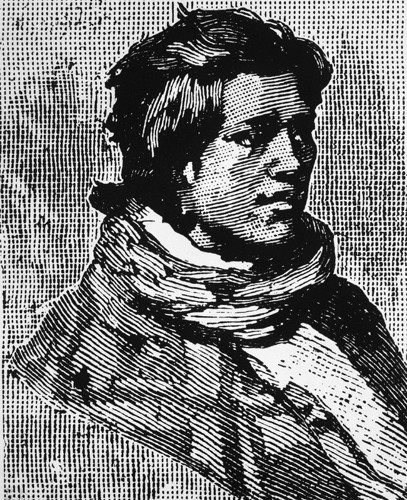
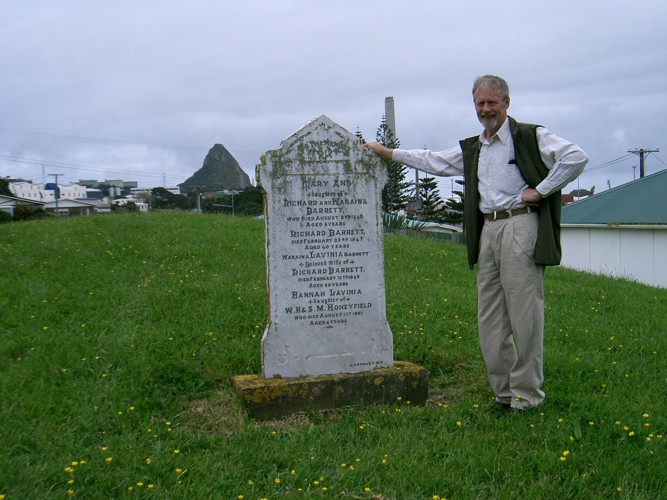
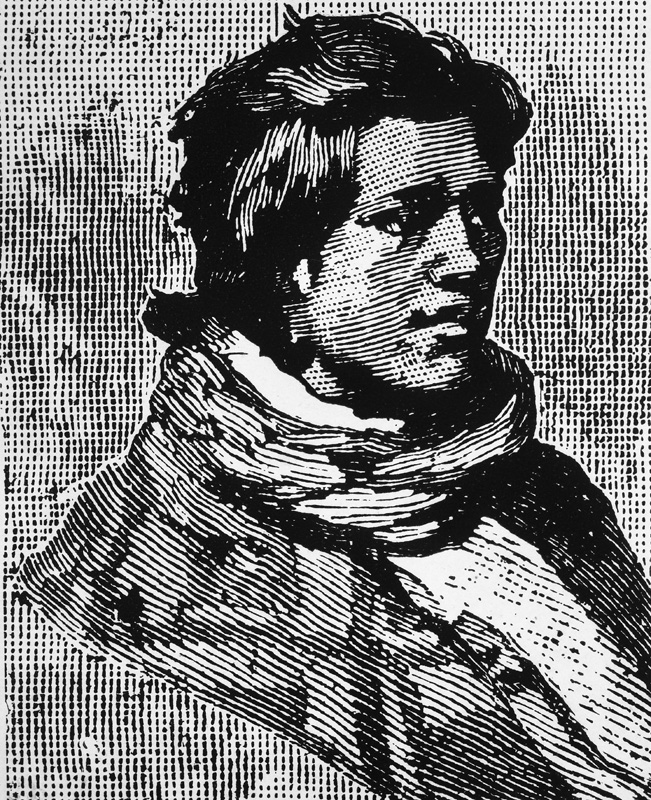
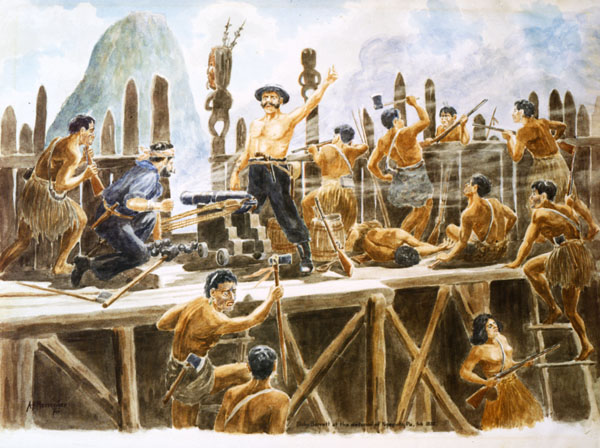
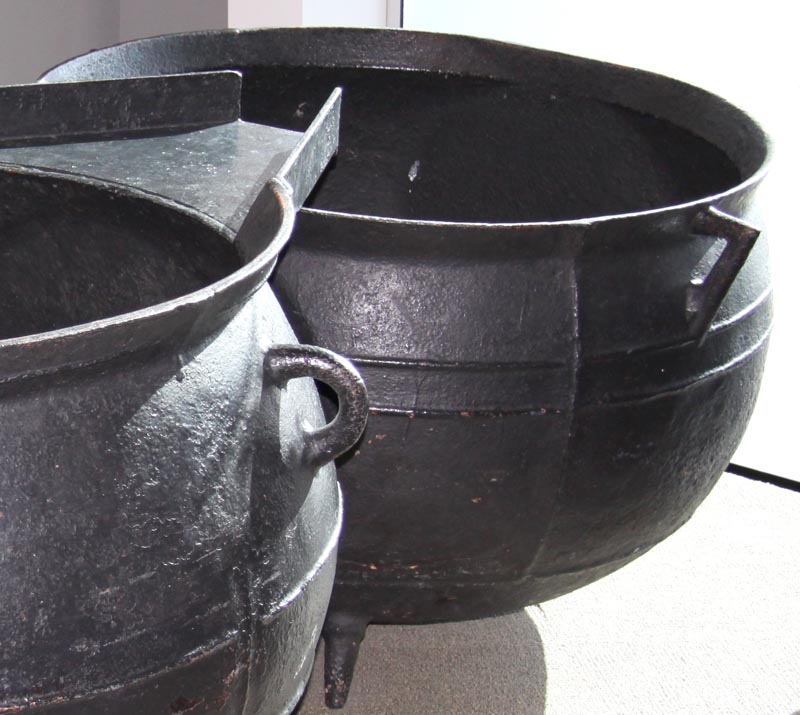
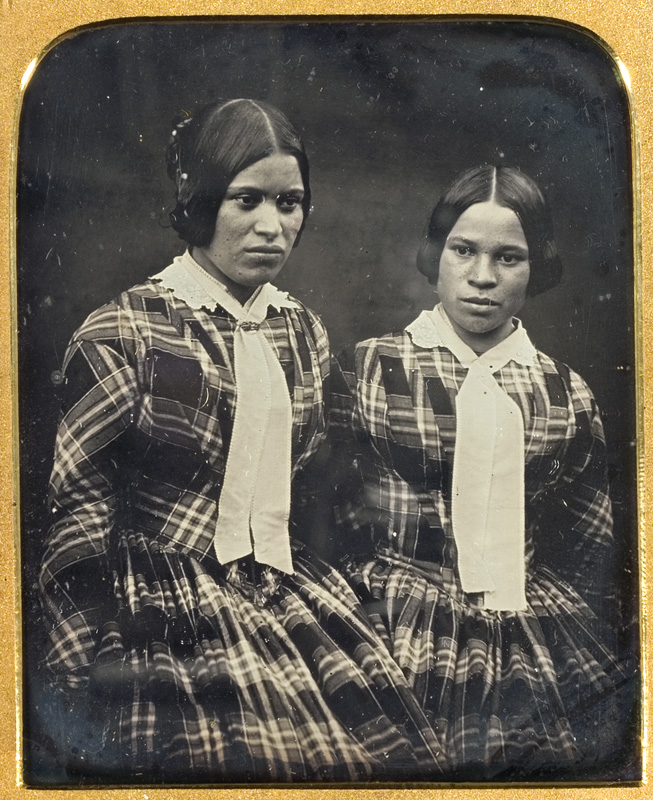
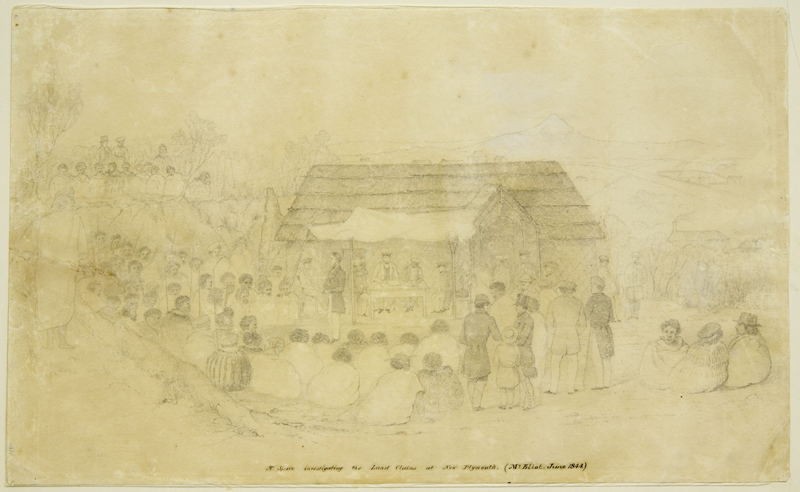
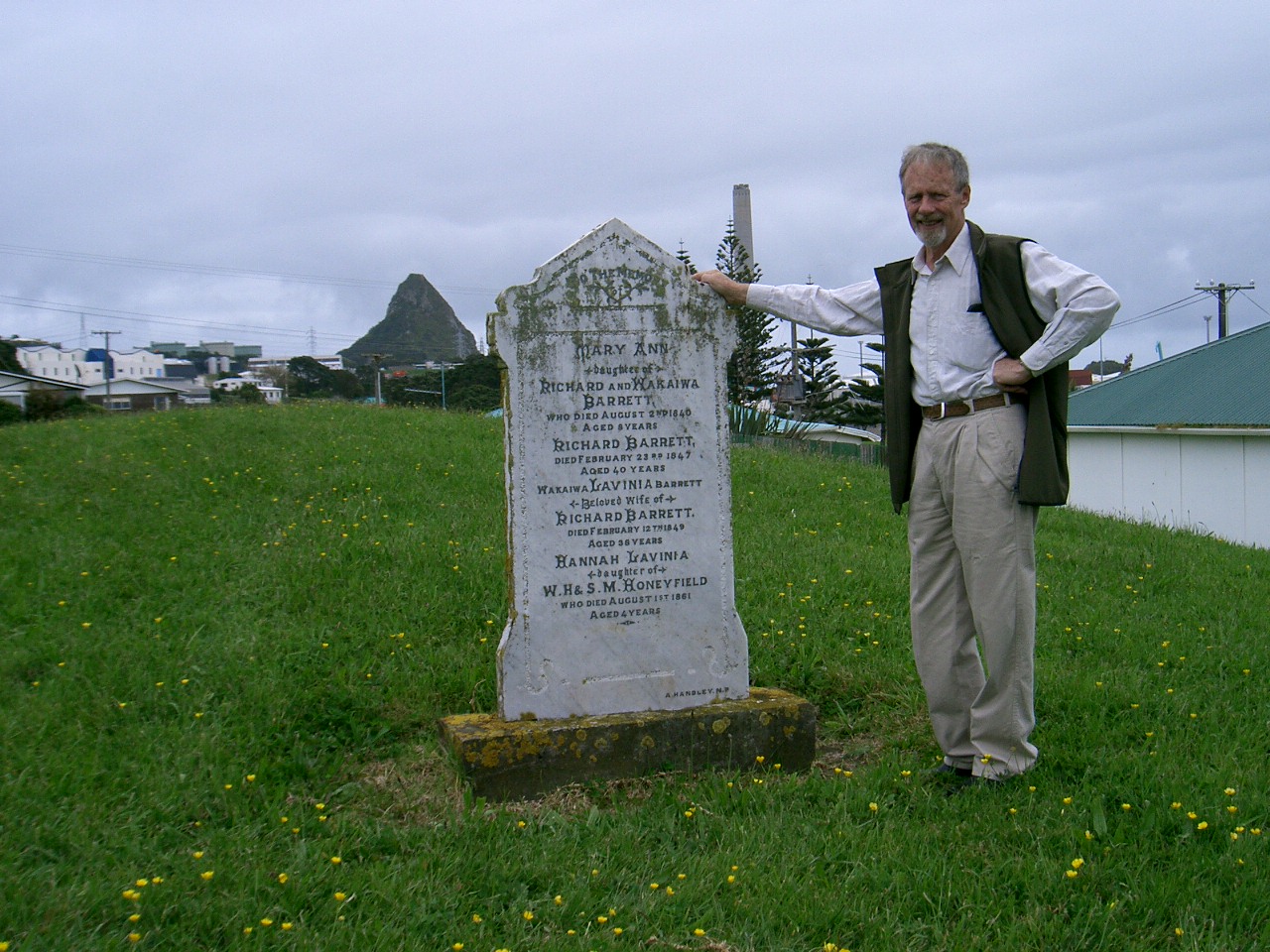
It's not known for certain, but it's thought Dicky Barrett was born in 1807, in either Durham or Bermondsey, both places of dirt and poverty, slums and alleyways. An amiable, respected, simple fellow, he had already been a seaman for six years when he sailed from England for Sydney in 1828, at the age of twenty-one. He signed on as first mate on the small Australian ship Adventure captained by his good friend John Agar Love, whom he called Jacky. What an interesting pair they must have made – Love, tall and fair-haired and Barrett quite the opposite, brown-haired and squat. Little did they know they were destined to stick together through many history-making years.
At the time, there was great demand in Europe for good processed flax to make naval rope, cordage and sails. Love and Barrett set out from Sydney on their first trading voyage to New Zealand, where they hoped to trade muskets for flax, as well as pigs and potatoes to ship to England. Some of the crew whose names survive were Billy Bundy, John Wright, James Bosworth, William Keenan, Daniel Sheridan, George Ashdown, William Keenan and Scipio Lee, an African-American cook.
In March 1828, the Adventure came down the west coast until the long curve of Ngāmotu lay to the left. In Māori, Ngāmotu means the islands, and was a fitting title for a beach with the Sugar Loaves and Paritūtū Rock in the distance. As the 12 metre wooden schooner passed, two long war canoes, each filled with dozens of paddlers, pushed out from the sand and headed towards the ship. In the waka sat two important chiefs, Te Puni and his cousin Te Wharepōuri of the Ngāti Te Whiti people, hapū of Te Ātiawa.
Te Puni carried himself with immense dignity, and his hair shone white as an egg above his completely tattooed face. He looked about fifty-three, perhaps fifteen years older than his cousin Te Wharepōuri, who wore his dark hair on top of his head, tied in a knot.
Barrett had been sailing the South Seas for many years, mixing with Māori in Sydney. He could speak a smattering of Māori, or pidgin Māori, where the language is broken down and simplified, so he was given the job of interpreter. “You must take your ship to Nga-motu” Te Wharepōuri told him, “Where there is plenty of muka [flax] and numerous pigs.”
The coastline suffered wild seas and there was no natural port, so even as late as 1820 Māori at Ngāmotu had not seen a Pākehā. One of the first Europeans to land in the area was possibly John Kent when he arrived on HMS Elizabeth Henrietta in 1823, on a trip to collect plant specimens. But sometime in the last few years, another European ship had visited and now they knew that white men brought iron tools, woollen blankets and muskets. Many of Te Ātiawa enemies already carried guns.
Te Wharepōuri and Te Puni had decided they should go into business with the white men and set up a partnership. Barrett and Love agreed. It would be much easier to pick up flax at Ngāmotu, or Moturoa as it was sometimes called, than travel New Zealand looking for it. They sheltered the ship in the shadow of the Sugar Loaves and dropped anchor.
Soon a relationship between Te Ātiawa and the Pākehā began, based on mutual desire. Barrett and Love wanted flax and other goods and Te Ātiawa wanted muskets, so a way had to be found to achieve this. Trade with the white people was a new concept to Māori. In their world the mana of a chief depended on what he did with his riches and he was expected to share them around.
Europeans were different - they liked to gather money and possessions to themselves. But each party agreed to compromise and cooperate and together they developed a workable middle ground. Barrett respected Te Ātiawa customs and Te Ātiawa took some things from European culture and left the rest.
A large trading post was built at Ngāmotu, named Patarutu and staffed with ten traders.
One night in May, soon after the Adventure arrived back at Ngāmotu, an anchor rope broke during a terrible gale and the ship washed up on the beach. The schooner was completely wrecked, leaving captain and crew stranded. Back they went to Sydney to find another ship, this time on the brig Elizabeth whose captain had heard of their plight and offered to pick them up. But they kept the news of good flax trading a secret. Instead they told people they'd been on a sealing voyage.
Barrett and Love eased their way into Māori society for economic gain. They became Pākehā-Māori, took Māori wives and were given Māori names. Dicky Barrett became Tiki Parete while John Love became simply Hakirau.
Barrett's wife Wakaiwa, or Rawinia as she was known, was a tall, handsome, high-born woman who towered over her husband. She was daughter of Eruera Te Puke ki Mahurangi, a leading Ngāti Te Whiti chief and Kura Mai Te Ra, daughter of Te Ātiawa paramount chief, Tautara.
Rawinia was also related to many other important Te Ātiawa chiefs, including Te Wharepōuri and Te Puni. For Barrett to be given Rawinia as a wife, showed his status and success and how respected he'd become. When the couple had children, they wore European clothes, spoke two languages and had Māori names as well as English.
For Māori, marriage meant a joining of groups, rather than individuals. But the Māori way of life was not always easy for the newcomers to understand. When a Pākehā married a Māori woman, they lived with her people and were given land to use in two ways. Either the wife brought it with her as a dowry or wedding present, or land was given to the husband by the chief. Though a husband couldn't actually own it, his children could. Barrett was allocated land close to Patarutu. Though it was really only loaned to him, he mistakenly came to believe he owned it.
While a Pākehā might be welcomed into tribal life, he remained an outsider. Even marriage to a tribe member did not mean he belonged to it, though his children did. He had to observe all tribal law, but that was a good thing, as it usually meant he was protected along with everyone else.
Back in Port Jackson, Love found other ships to replace the wrecked Adventure and carry large cargoes of muka over the sea. The Admiral Gifford made two trips, and Currency Lass carried goods on consignment. Soon different ships followed them into Ngāmotu, as Patarutu became well known as a busy trading post.
Te Ātiawa had to step up their farming methods to grow enough produce for trade, and Barrett introduced melons, maize, cabbages, pumpkins and wheat especially for the export market. Peach trees came from Sydney.
Usually Māori grew only enough to use themselves, but now, if they wanted more muskets they had to harvest more flax. Though the yield increased, it was often hard to sustain. Several times a year workers left their fields to go into battle with warring tribes. The increase in pigs meant fencing seemed continuous.
It hadn't taken Barrett and his men long to realise why muskets were so important to the tribe. Everyone at Ngāmotu lived under the threat of war from the northern tribes and had done for four long years, ever since Motunui, where a battle had taken place that had shattered all hope of peace.
In the early 1820's north of Urenui, at a place called Motunui, Te Ātiawa and their allies had fought a bloody battle with an army of mixed Tainui tribes. Tainui had carried guns for nearly twenty-years and had used them to terrorise all the tribes around them, particularly Ngāti Toa who lived inland at Kāwhia and who were old Te Ātiawa friends. Though Ngāti Toa had stood their ground using only traditional weapons, chief Te Rauparaha knew Tainui hapū (Waikato and Ngāti Maniapoto) badly wanted their land. One day they would take it from them and they'd be slaughtered in the process.
Te Rauparaha decided to save his people by leading them south to Kapiti and let Tainui take the land. It should have been that easy, but Tainui continued the fight and chased them all the way to Motunui. Because it was their land, Te Ātiawa joined in, and together they won a surprising victory.
Eventually Ngāti Toa carried on their way, but Te Ātiawa knew the meaning of utu (revenge). In December 1831 the word went out. The great Tainui chief, Te Wherowhero, with his assembled a hoard of Waikato and Te Maniapoto warriors were coming!
If Te Wherowhero was coming, it meant war! Kumara and potatoes were dug and piled in storage pits. Men hurried to construct whare, dig ditches, build bullet-proof clay banks. The Ōtaka pā stood on a steep hill, probably where the Moturoa Cool Stores are today, but it was a small pā compared to some. Te Ātiawa people enclosed the villages of both Ōtaka and Matipu in a single line of palisades and hoped it would hold.
On Christmas Eve 1831, camp fire lights from Te Wherowhero's war parties (taua) could be seen out along the northern coast. He and his warriors were heading for Ngāmotu. They would reach Ōtaka pā on 30 January 1832.
Te Wherowhero was a formidable fighter, tall, with a mighty body. The battle at Motunui had made him famous - he'd fought and killed dozens of enemy single-handed. Legend has it he sent word to Barrett and Love that he intended to cut off their heads and preserve them. Barrett responded he quite liked his head where it was.
Now those at Ōtaka pā began to wonder about two Waikato canoes that had pulled into Waitara a short time before, and whether they might have carried spies. Perhaps Te Wherowhero knew it was a good time to attack. There were only scattered remnants of tribes living between Mōkau and Ngāmotu now, as many Ngāti Mutunga and Ngāti Tama iwi had tramped off south to avoid bloodshed. And Te Ātiawa had gone with them.
Soon refugees began arriving at Ōtaka pā, all Te Ātiawa people who had fled from their tribal land a little to the north. Once they would have stayed to defend it, but they had seen far too many gun barrels shining in the sun. Dropping their hoes in the field, they'd run to the safety of Pukerangiora, the strongest pā in the district, on the banks of the Waitara river. It should have been the safest place to go except it was now filled with terrified and disorganised refugees and there was no longer enough food.
Later, terrible tales would be told about the siege at Pukerangiora, how Te Wherowhero's warriors sat outside and held everybody hostage. How weeks went by without food, and hunger drove some hostages out, only to be killed or held prisoner. Te Wherowhero ordered those with fine tattoos to be carefully beheaded so their mokomōkai could be saved for trade. But others were systematically butchered and prepared for food. Only slaves survived, or those destined to be Tainui dinners further down the track.
At Ngāmotu, Ōtaka pā also filled with fugitives, as well as reinforcements arriving from Puke Ariki, Pukaka and other pā close by. Three cannons, thought to have been bought from a passing ship, were hauled up the hillside and propped inside. They had Māori names - Ruakoura, Onepoto and Pupoipoi.
The cannons were very old, made at the turn of the 17th Century. Sea and salt had corroded the barrels and there weren't enough cannon balls. Makeshift carriages made them difficult to aim and dangerous to fire, and the recoil could knock a man senseless. As instruments of war they were next to useless.
For extra cannon fodder, Barrett and his men filled powder bags with anything they could find - stones, pieces of iron, broken glass. Though there were good reserves of gunpowder, ammunition for the muskets was low. The 350 men in the pā carried traditional weapons and 100 muskets.
When Te Wherowhero marched along the seashore, no one was very surprised. With him came 1600 warriors, plus women and slaves captured at Pukerangiora. At Ōtaka they watched from the palisades as the taua split into two at the Huatoki stream and began to surround the pā.
Down on the beach, Te Wherowhero began to wave his mat as a sign he wanted to talk. Several chiefs from the pā, including Te Wharepōuri went down on the sand to meet him.
There are two differing accounts of what happened next. Some say the chiefs made a pact to keep the peace for several days, whereby the Waikato warriors stamped a haka in front of the pā, fired their guns in salute, before throwing them down on the ground. But as they rushed forward to rub noses with relatives inside, Barrett and the others opened fire and bodies fell everywhere. Those still holding guns retaliated. Tainui took the view that the besieged had broken the peace. Others say that the Pākehā considered the peace agreement to be nothing more than treachery and fired the first shots. Whatever the truth, a bloody battle began that would last three weeks.
Another attempt at peace was made four days later. But when Te Wherowhero asked to come inside the pā and hold a tangi for his dead, Te Ātiawa again grew suspicious and said no. A final try took place on the deck of Currency Lass, newly arrived off shore for a shipment of flax. Love and Te Wherowhero talked on deck - neutral territory. When the chief suggested a deal that would let him trade all the flax in Patarutu and take the white men to Kāwhia as slaves, Love refused.
The Māori way of war is very different to the European and Barrett and his companions often found they were following bizarre rules. Māori leaders did not lead but attempted to persuade their men into battle. Neither camp would attack during the hours of darkness, something that seemed so strange to Barrett and Love that they wore themselves out trying to stay awake all day and night. It astounded them to see warriors from both sides sleeping calmly in their trenches with blankets or mats pulled over them. Families from each side would get together inside the pā for a friendly chat. And Tainui chiefs wandered in for a meal, examined the cannons, took note of Te Ātiawa battle tactics and loudly pointed out where they were likely to go wrong. As provisions grew short, Tainui even bartered for food and tobacco with muskets seized at Pukerangiora.
Yet all during the day, the enemies built towers and engaged in sniper fire. The attackers cut down karaka trees for ladders to breach the walls. When flaming torches sailed into the pā and onto the roofs of the whare, Te Ātiawa warriors fired back from the battlements.
For the most part, Te Ātiawa were good fighters, yet Barrett found the pā a place of great confusion and noise. Filled with gunfire and loud boasting from warriors of their various skills, often those on the same side squabbled and fought each other. There were times Barrett thought it was more dangerous inside than out.
When two sisters on opposite sides argued, the one who had sided with Waikato rushed out to be with them, only to be killed immediately and chopped into pieces to be cooked. Waikato washed her body in the Hongihongi stream, making the water tapu and unfit to drink. Fortunately, wells were dug and alternative water found, which meant people in the pā did not go dry.
In late February, under the cover of darkness, thirty or forty Ngāti Tama warriors arrived by canoe and crept up the hill, to help defend the pā. But what should have been a celebration quickly turned to woe when the smallest cannon blew up. To all those in Ōtaka, it seemed a bad omen. But not to Te Wherowhero, who thought it a good sign. Food supplies were completely gone and he'd just been given the news that other enemies had invaded their homes at Mōkau. Tired of being hungry and sick of an unexpectedly long battle at Ngāmotu, he decided to pack up his men, go back and protect their land. But first, in the usual fashion, he told all Te Ātiawa that he would strike them hard in the morning and slaughter them all first.
As promised, on the morning of 20 February 1832, Te Wherowhero's warriors attacked, staying long enough for a short hard fight amid belching cannon fire. For the first time, the cannons were effective. Mounted on three sides of the pā, they mowed down many invaders who, in a hurry to be gone, were reckless and not organised.
Before they withdrew, Waikato and Te Maniapoto piled their dead on the roof of the temporary whare they'd built during the siege, setting fire to them so they couldn't be eaten by the enemy. Then they began the long trek back to Mōkau, lamenting the loss of four important tribal chiefs and sixty lesser ones.
It was said later that when Te Wherowhero's people left, Te Ātiawa chased after them, inflicting two hundred further casualties. It was also recorded that, “...the victorious defenders fed their injured and defeated enemies and gave a pious Christian burial to their dead”. Another report said, “...dismembered Waikato carcasses decorated Ngāmotu doorways, days of celebration and feasting followed, dogs ate their fill, February flies came in clouds, and Barrett, Love and the seamen could only look on in revulsion, thankful that it had not been their fate.”
Sheridan, who, like most white men, found cannibalism utterly disturbing, wrote: “Oh, what a scene for a man of Christian feeling to behold, dead bodies strewn about the settlements in every direction. By great persuasion we prevailed on the savages not to cook any inside the fence or to come into our houses during the time they were regaling themselves.”
When Te Ātiawa buried their fallen chiefs, Barrett and Love were dismayed - eight valued muskets went into the grave with everyone. The battle might be won, but not the war. Like everyone in Ngāmotu, they knew they might not be lucky enough to win another round. The smell of utu still carried strongly on the wind.
In June 1832, the Te Ātiawa tribe along with Barrett and Love, led by chiefs Te Puni, Te Wharepōuri and Te Tautara, set out on Te Heke Tama Te Uaua - the great trek south along the Whakaahurangi track. They knew it was just a matter of time before Waikato struck again.
Rangipoto, who was on the march, tells the story: “There were many of us, some 1400 fighting men, without counting women or children. Each tribe marched in a body and close to each other so that none might be left behind, nor was there any straggling allowed. The men of each tribe marched in front and behind, the women and children between them, and certain men were sent off to see that the distance between each party was maintained. We slept in the forest the first and succeeding night. It was cold, being winter [June] and the frost was on the ground. The kakas [parrots] were very fat at the time...”
One small group stayed behind on the semi-island fortress of Mikotahi, to keep the home fires burning, ensuring the land stayed occupied. Te Ātiawa people might one day return, when they had gathered strength.
History has often made heroes of Barrett and Love for winning the battle at Ōtaka, but perhaps they were fighting simply to survive. They could almost be seen as extras in a bloody battle scene - not necessarily the key to victory, but more like accidental Pākehā warriors, who at times, because of their lack of understanding of Māori war tactics, might actually have made things worse.
In 1839, the Tory pulled into the Sugar Loaves with Barrett and family aboard. For six years Barrett had been whaling at Te Awaiti at Queen Charlotte Sounds. Now he was employed by Edward Jerningham Wakefield of The New Zealand Company as interpreter to help negotiate the purchase of Māori land. Together they had already bought land at Wellington - though not without sweat and tears - and while Barrett didn't always like the way Wakefield did business, he agreed to go with him to buy land at Ngāmotu from his wife's Te Ātiawa iwi.
When he first saw the land, Wakefield was not impressed. The place was practically deserted. The old pā had fallen down a long time ago, karaka and flax grew everywhere and even the cannon from the Ōtaka battle lay abandoned on the beach. Leaving Barrett behind to do business, Wakefield sailed for the Hokianga to find more land up there. Barrett installed his family on Moturoa Island, safe from any danger.
It would not be an easy land sale. Almost before Barrett set up camp, William White, a disgraced Wesleyan minister, arrived with a deed, saying he had already bought most of Taranaki from Waikato and Maniapoto chiefs, who owned the land by historic conquest.
Next came the Reverend Whiteley, demanding land for his mission. Te Ātiawa, of course, argued the land was theirs. But they were told it was in their best interests to sell, “in order that they may return to their native place without fear of the Waikato”.
Eventually Barrett convinced the iwi to sign over the land, though it's unlikely they knew they were about to lose all their rights to it. They had never sold land before. Perhaps, like Te Wharepōuri in Wellington before them, they thought they were simply giving permission for the Pākehā to live amongst them.
As Te Wharepōuri had said: “I thought you were telling lies, and that you had not so many followers. I thought you would have nine or ten, or perhaps as many as there are at Te Awaiti. I thought that I should get one placed at each pa, as a white man to barter with the people and keep us well supplied with arms and clothes; and that I would be able to keep the white man under my hand and regulate their trade myself. But I now see that each ship holds two hundred, and I believe, now, that you have more coming.”
Māori understanding of the purchasing process cannot have been aided by Barrett's translation methods. In Wellington he'd turned a 1600 word document, written in English, into 115 meaningless Māori ones.
As part payment, the chiefs demanded double-barrelled guns, which had been offered for payment elsewhere.
“No guns, no sale” they said.
“I'll sail away” Barrett warned.
“Sail” the chiefs said.
But Barrett was not above a little blackmail. He threatened to take his children with him - the chiefs' mokopuna - and eventually all the chiefs signed. Soon the Taranaki tribe would follow suit and sell their land as well.
The New Zealand Company now owned two huge tracts of land from Mōkau to Ngāmotu, and from Cape Egmont to the top of the mountain and down to the upper reaches of the Whanganui River. All that was needed to seal the bargain were to deliver the goods worth £500. When hapū fought over how best to divide them, Barrett kept the peace. The double-barrelled guns never eventuated. Te Ātiawa would remind Barrett about them for the rest of his life.
The total land buy-up by the New Zealand Company had reached nearly 810,000 hectares (2,001,554 acres), to be on-sold to settlers. Trouble brewed unexpectedly when Lieutenant-Governor William Hobson decided to investigate the legal ramifications of such a major grab, decreeing any land sales made after 30 January 1840 to be null and void.
Because of a twist of fate the Ngāmotu deal had been signed late. Wakefield's ship had struck a sandbank and he was late coming back. Barrett's land deal now hung by a legal thread.
Barrett returned to Wellington and opened a hotel. But by 1841 he was back at Ngāmotu with surveyor Frederic Alonzo Carrington, who had arrived to mark out the 4,451.54 hectares (11,000 acres) settlement of New Plymouth. Barrett and his entire household plus two whale boats sailed with him.
At first Carrington favoured Waitara, and then Moturoa, but Barrett decided to set up a whaling station there. Carrington called it “a horrible nuisance” and changed site to further along the beach, between Huatoki and Te Hēnui streams. He wanted his town well away from whalers and whale remains.
The land was soon cleared by burning. Te Ātiawa, trickling back from down south, were disgusted by the way it looked. Upset with the surveyors, as well as with their own relatives who had sold the land in their absence, they again demanded the double-barrelled guns they were promised.
Carrington wrote to Wakefield: “...Mr Barrett tells me when this place was purchased from the Natives, that an agreement was made to make some few presents to the Chiefs ...if you will be so kind to send me guns that were promised them...I fear from what I have seen, unless the promise is fulfilled, we may have some little trouble...”
And then the Settlers came. In 1841 the William Bryan arrived, bringing New Plymouth's first settlers. Barrett's men and boats unloaded the ship and Barrett became unofficial harbour master. Settlers dragged their baggage along three kilometres of blackened wasteland but within a few weeks, a new town had taken shape.
Barrett had already built a long reed house next to the Māori village at Ngāmotu and beside his whaling station. Missionaries lived alongside, and then the surveyors, and finally, on the slopes of town were the settlers, impatient for title to some land. With the New Zealand Company under investigation and constant rumours of attack from northern tribes, it was a nervous situation, but a colonist wrote in his journal, “that Barrett has them all under control”.
Whalers were an unruly bunch, despised for their rough habits and heavy drinking, and Barrett's were no exception. That year another whaler, Richard Brown, turned up to build a second station next to Huatoki stream. Townspeople raised loud objections after Brown's first kill, and he decided to move his station to Moturoa, next to his friendly rival.
Though Barrett remained his usual good-humoured self and popular with everyone, his whaling business did not do well. He couldn't seem to catch the whales as easily as he had at Te Awaiti, and when he did they yielded less oil. He owed money on his boats and other equipment, and though he sold his hotel in Wellington for £1500 to pay his debt, the money he made didn't cover it. His little house next to the hotel sold for £30 and became Wellington Library.
Things were not too good for the settlers either. It had rained for weeks, rations were short and there was no flour left. Te Ātiawa were hungry, too. Though they had planted extra crops to feed the Europeans, many more than expected had turned up and eaten more than they'd planned.
The Amelia Thompson sat out to sea for seven weeks, waiting for clement weather so the next batch of immigrants might get to shore.
Despite his knowledge and volunteer help, Barrett was passed over for the job of official harbour master. The health of his crew declined. A plague of rats ate everything they could scavenge. One man was said to have killed 500 rodents in two months, before they disappeared along the beach, paw prints all pointing the same way.
In Wellington, hearings began to decide if Barrett's Ngāmotu land purchase was legal. Because of the increasing unrest between Pākehā and Māori, lawyer William Spain was sent by the British Government as Land Claims Commissioner to examine the New Zealand Company deals.
By 1843, Barrett's fortunes had not improved. He had not built a big house as he had in Te Awaiti, but lived in a simple whare-type dwelling on 5.67 hectares (14 acres) of disputed land. He gave up plans for a hotel in New Plymouth and turned his hand to farming. When grasshoppers ate his root crops and worms invaded his wheat, he began to think that cattle and sheep might be better options.
More settlers arrived on the Blenheim and Essex until the head count in town was 900, more than twice that of the Māori population. Rumours of Waikato invading continued. Though no war party appeared, large numbers of settlers were sworn in as special constables, just in case. Te Ātiawa grew sullen and wary, thinking it was just another plot to snatch their land, especially the much sought-after fertile soil of Waitara.
Quietly, they removed fences and let out the stock. When double-barrelled guns finally arrived, they refused to take them in fear the white man might want even more land in return. When nearly 200 unarmed Māori sat on Waitara Road so it couldn't be surveyed, angry townspeople responded with a letter to authorities, insisting Māori were trying to thwart their peaceful farming attempts.
In May 1844, Commissioner Spain arrived to settle ownership. He promptly declared Māori had lost all their rights through historic conquest when they became slaves to the Waikato, and that the Governor had since bought those rights from their conquerors! Te Ātiawa iwi were understandably upset. Spain said he would hold an investigation but only present residents of the land would have their rights considered, and no one could claim rights to two places at once.
Barrett took the stand but he was looking out for himself. The questions flew back and forth with Barrett swinging from truth to evasion. He explained the buying process he'd used and stated he felt he had truly bought the land, but he had to admit the final deal had taken place without all the necessary tribe members present.
Spain closed the court after just one week, declaring Te Ātiawa had no rights to their land at all, because they had not properly presented their case. He awarded the New Zealand Company 24,000 hectares (59,305 acres), Wesleyan missionaries 40 hectares (99 acres), and Barrett 73 hectares (180 acres) at Ngāmotu, which left Te Ātiawa with less than a tenth of the company's share. Now Te Ātiawa grew justifiably angry.
Somehow Spain decided the land had been taken and colonised for Māoridom's own good. He told Te Ātiawa they were already benefiting from the European - no more wars, good clothes, money and religion which would certainly ensure their happiness in the future. Finally, he ordered Governor Fitz-Roy to “enforce obedience of the laws” and said any further argument was futile.
It was an arrogant decision, yet Te Ātiawa were calm and gentle in their protest. They sat down and wrote to Fitz-Roy that they did not want the settlers to leave, just not to settle in certain places, particularly Waitara. They asked, did he not love England the way they loved Waitara? They vowed Waitara land would not be given up. Without waiting for a reply, they moved in quietly and quietly removed the settler's possessions. This was the very beginning of conflict that resulted in the 1845 New Zealand Wars.
Fitz-Roy was sympathetic. He did not like the ruling and said it was like British prisoners-of-war returning home to find all their estates gone. But he couldn't do anything about it, except to blame Barrett, calling him “an interpreter incapable of translation”.
Barrett's fall from grace was swift and harsh. Suddenly, he went from a man of mana to being known as Dirty Dick as he became something of a scapegoat for the whole affair. People in the street ignored him. No one needed his help. Te Ātiawa turned their backs, realising he had contributed to their plight.
As the district filled with arms and unsettled politics, Barrett took sick but recovered well enough to see a last whaling season. He died at Moturoa on 23 February 1847. A note was sent to Wakefield which read, “...the old whaler, Barrett, died yesterday...” Barrett was only forty.
When this account of his death appeared in Taranaki Herald almost a hundred years later, it sounded like one of his own tall stories: “...The whale was spouting blood in a vortex of spume when Dicky Barrett ran in to put the finishing lance into its 'life'. Suddenly the cry went up: 'There she's fluked - by Jove - she's done for Barrett.' The great tail appeared to fall on the boat, which, for the moment was lost to view in the churning cauldron worked up by the dying whale. Soon, however, Dicky Barrett was lifted from her bottom, insensible, and carried ashore. He lay on the warm sand for some time above high-water mark. Then he was half-carried and half walked between two strong supporters to Mr Richard Brown's...”
As with the details of his birth, no one knows for sure if it's true or not. Some say Barrett died of apoplexy, some say of a heart attack. But one thing is certain - he lived and played an active role in New Plymouth's turbulent history, and his name still survives: Barrett Lagoon, Barrett Reef, Barrett Domain, Barrett Road, Barrett Street.
Sitting across the table from John Honeyfield, I think he must wear the same kind of twinkle in his eye that Dicky Barrett did. John is a direct descendant of the Barrett family - his great-great-grandmother Caroline was Dicky Barrett's daughter.
When I ask if he is anything like Dicky Barrett, he smiles. “When I first left school I had a strong ambition to go to sea!” At sixteen, not much older than the legendary Barrett when he embarked on his first voyage, John sailed as Deck Cadet on the Shaw Savill Line, but gave it up after an “unfortunate year”.
“On my first trip back from England I had appendicitis. And then sailing across the Tasman next time, I had an infection in the throat and had to be hospitalised in Melbourne.” Could there be a connection between Barrett's whaling and John's wish to sail on sea-faring vessels? Who knows... maybe...? “Some of my uncles loved wheeling and dealing. Buying and selling things. They were farmers but they really enjoyed going off to the sales. That could come from the trading side of things.”
The Honeyfields are a big bunch, and John has always been interested in his famous forebear. Contrary to popular belief, he believes the whaler was well educated for his time. “He could read and had a fine hand of writing. I've always understood he wrote his own will.”
Does he believe the story that Barrett had two illegitimate sons, supposedly born at the same time? “I have no knowledge of that. That story was never told to us as children.” Somehow, he doubts it. Barrett appeared to have been such a family-oriented man. “He brought up Love's children after he died.” Love was Captain of the Adventure and Barrett's best friend.
John says not many family stories exist because Barrett was already dead when the Honeyfield brothers married the Barrett sisters, Caroline and Sarah. “Dicky died six years before the Honeyfields even arrived in New Plymouth, something people can forget.”
He is still asked occasionally, to go down to Moturoa's Waitapu urupā to identify the unmarked graves. Only Barrett's and one other Pākehā grave are marked, though records show at least 70 people are buried there. “Mostly Europeans and some Māori, though it's hard to know. Māori didn't keep records.”
He says he was always told Barrett died from pneumonia, resulting from injuries after his encounter with a whale. “It makes sense. The story is he fell into the boat. Perhaps he cracked his ribs.” He grins broadly. “Although it could have been from that infernal pipe he smoked.” It's exactly the kind of joke that Barrett might have made himself. Perhaps some of Barrett's traits did come down the line.
Caughey, A. (1998). The Interpreter: The Biography of Richard 'Dicky' Barrett. Auckland: Bateman.
McLean, R.W. (1994). Dicky Barrett: Trader, Whaler, Interpreter. Auckland: University of Auckland.
Puke Ariki Heritage Collection: Dicky Barrett
LinkPlease do not reproduce these images without permission from Puke Ariki.
Contact us for more information or you can order images online here.